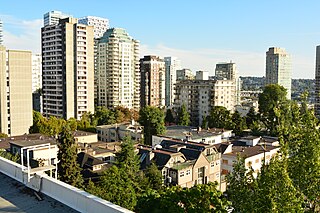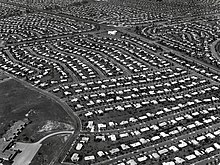
A suburb is an area within a metropolitan area which is predominantly residential and within commuting distance of a large city. Suburbs can have their own political or legal jurisdiction, especially in the United States, but this is not always the case, especially in the United Kingdom, where most suburbs are located within the administrative boundaries of cities. In most English-speaking countries, suburban areas are defined in contrast to central city or inner city areas, but in Australian English and South African English, suburb has become largely synonymous with what is called a "neighborhood" in the U.S. Due in part to historical trends such as white flight, some suburbs in the United States have a higher population and higher incomes than their nearby inner cities.

Smart growth is an urban planning and transportation theory that concentrates growth in compact walkable urban centers to avoid sprawl. It also advocates compact, transit-oriented, walkable, bicycle-friendly land use, including neighborhood schools, complete streets, and mixed-use development with a range of housing choices. The term "smart growth" is particularly used in North America. In Europe and particularly the UK, the terms "compact city", "urban densification" or "urban intensification" have often been used to describe similar concepts, which have influenced government planning policies in the UK, the Netherlands and several other European countries.

In urban planning, zoning is a method in which a municipality or other tier of government divides land into "zones", each of which has a set of regulations for new development that differs from other zones. Zones may be defined for a single use, they may combine several compatible activities by use, or in the case of form-based zoning, the differing regulations may govern the density, size and shape of allowed buildings whatever their use. The planning rules for each zone determine whether planning permission for a given development may be granted. Zoning may specify a variety of outright and conditional uses of land. It may indicate the size and dimensions of lots that land may be subdivided into, or the form and scale of buildings. These guidelines are set in order to guide urban growth and development.

A residential area is a land used in which housing predominates, as opposed to industrial and commercial areas.

Urban sprawl is defined as "the spreading of urban developments on undeveloped land near a more or less densely populated city". Urban sprawl has been described as the unrestricted growth in many urban areas of housing, commercial development, and roads over large expanses of land, with little concern for very dense urban planning. Sometimes the urban areas described as the most "sprawling" are the most densely populated. In addition to describing a special form of urbanization, the term also relates to the social and environmental consequences associated with this development. In modern times some suburban areas described as "sprawl" have less detached housing and higher density than the nearby core city. Medieval suburbs suffered from the loss of protection of city walls, before the advent of industrial warfare. Modern disadvantages and costs include increased travel time, transport costs, pollution, and destruction of the countryside. The revenue for building and maintaining urban infrastructure in these areas are gained mostly through property and sales taxes. Most jobs in the US are now located in suburbs generating much of the revenue, although a lack of growth will require higher tax rates.
Inclusionary zoning (IZ) is municipal and county planning ordinances that require or provide incentives when a given percentage of units in a new housing development be affordable by people with low to moderate incomes. Such housing is known as inclusionary housing. The term inclusionary zoning indicates that these ordinances seek to counter exclusionary zoning practices, which exclude low-cost housing from a municipality through the zoning code. Non-profit affordable housing developers build 100% of their units as affordable, but need significant taxpayer subsidies for this model to work. Inclusionary zoning allows municipalities to have new affordable housing constructed without taxpayer subsidies. In order to encourage for-profit developers to build projects that include affordable units, cities often allow developers to build more total units than their zoning laws currently allow so that there will be enough profit generating market-rate units to offset the losses from the below market-rate units and still allow the project to be financially feasible. Inclusionary zoning can be mandatory or voluntary, though the great majority of units have been built as a result of mandatory programmes. There are variations among the set-aside requirements, affordability levels, and length of time the unit is deed-restricted as affordable housing.

Suburbanization (AE), or suburbanisation (BE), is a population shift from historic core cities or rural areas into suburbs, resulting in the formation of (sub)urban sprawl. As a consequence of the movement of households and businesses away from city centers, low-density, peripheral urban areas grow.

A single-family detached home, also called a single-detached dwelling,single-family residence (SFR) or separate house is a free-standing residential building. It is defined in opposition to a multi-family residential dwelling.

A duplex house plan has two living units attached to each other, either next to each other as townhouses, condominiums or above each other like apartments. By contrast, a building comprising two attached units on two distinct properties is typically considered semi-detached or twin homes but is also called a duplex in parts of the Northeastern United States, Western Canada, and Saudi Arabia.
The YIMBY movement is a pro-infrastructure development movement mostly focusing on public housing policy, real estate development, public transportation, and pedestrian safety in transportation planning, in contrast and in opposition to the NIMBY movement that generally opposes most forms of urban development in order to maintain the status quo. As a popular organized movement in the United States, it began in the San Francisco Bay Area in the 2010s amid a major housing affordability crisis and has subsequently become a potent political force in state and local politics across the United States.
A planned unit development (PUD) is a type of flexible, non-Euclidean zoning device that redefines the land uses allowed within a stated land area. PUDs consist of unitary site plans that promote the creation of open spaces, mixed-use housing and land uses, environmental preservation and sustainability, and development flexibility. Areas rezoned as PUDs include building developments, designed groupings of both varied and compatible land uses—such as housing, recreation, commercial centers, and industrial parks—within one contained development or subdivision. Developed areas vary in size and by zoned uses, such as industrial, commercial, and residential. Other types of similar zoning devices include floating zones, overlay zones, special district zoning, performance-based codes, and transferable development rights.

Affordable housing is housing which is deemed affordable to those with a household income at or below the median as rated by the national government or a local government by a recognized housing affordability index. Most of the literature on affordable housing refers to mortgages and a number of forms that exist along a continuum – from emergency homeless shelters, to transitional housing, to non-market rental, to formal and informal rental, indigenous housing, and ending with affordable home ownership.

Mixed use is a type of urban development, urban design, urban planning and/or a zoning classification that blends multiple uses, such as residential, commercial, cultural, institutional, or entertainment, into one space, where those functions are to some degree physically and functionally integrated, and that provides pedestrian connections. Mixed-use development may be applied to a single building, a block or neighborhood, or in zoning policy across an entire city or other administrative unit. These projects may be completed by a private developer, (quasi-)governmental agency, or a combination thereof. A mixed-use development may be a new construction, reuse of an existing building or brownfield site, or a combination.

Secondary suites (also known as accessory dwelling units (ADU), in-law apartments, granny flats, granny annexes or garden suites) are self-contained apartments, cottages, or small residential units, that are located on a property that has a separate main, single-family home, duplex, or other residential unit. In some cases, the ADU or in-law is attached to the principal dwelling or is an entirely separate unit, located above a garage, across a carport, or in the backyard on the same property. Reasons for wanting to add a secondary suite to a property may be to receive additional income, provide social and personal support to a family member, or obtain greater security.

Zoning is a law that divides a jurisdiction's land into districts, or zones, and limits how land in each district can be used. In the United States, zoning includes various land use laws enforced through the police power rights of state governments and local governments to exercise authority over privately owned real property.
Exclusionary zoning is the use of zoning ordinances to exclude certain types of land uses from a given community, especially to regulate racial and economic diversity. In the United States, exclusionary zoning ordinances are standard in almost all communities. Exclusionary zoning was introduced in the early 1900s, typically to prevent racial and ethnic minorities from moving into middle- and upper-class neighborhoods. Municipalities use zoning to limit the supply of available housing units, such as by prohibiting multi-family residential dwellings or setting minimum lot size requirements. These ordinances raise costs, making it less likely that lower-income groups will move in. Development fees for variance, a building permit, a certificate of occupancy, a filing (legal) cost, special permits and planned-unit development applications for new housing also raise prices to levels inaccessible for lower income people.

Missing middle housing refers to a lack of medium-density housing in the North American context. The term describes an urban planning phenomenon in Canada, the United States, Australia and more recent developments in industrialised and newly industrialising countries due to zoning regulations favoring social and racial separation and car-dependent suburban sprawl.
California Senate Bill 50 was a proposed California bill that would have preempted local government control of land zoning near public transit stations and jobs centers. The bill would have also required, at minimum, four-plex residential zoning statewide. The bill was the successor to a similar bill introduced by state senator Scott Wiener in January 2018 as Senate Bill 827 ; both would have applied to areas within one-half-mile (0.8 km) of frequent transit corridors, including rail stations and bus routes. The bills were sponsored by California YIMBY, a pro-housing lobbying group while they were opposed by local governments, anti-gentrification activists, and suburban homeowners. The bills were written in response to an ongoing housing affordability crisis in California's largest urban areas.

Single-family zoning is a type of planning restriction applied to certain residential zones in the United States and Canada in order to restrict development to only allow single-family detached homes. It disallows townhomes, duplexes, and multifamily housing (apartments) from being built on any plot of land with this zoning designation.

Low-rise high-density housing refers to residential developments typically 4 stories or less in height, with a high number of housing units per acre of land, between 35-80 dwellings per hectare. This housing type is said to provide a middle ground between detached single-family homes and high-rise apartment buildings.



















